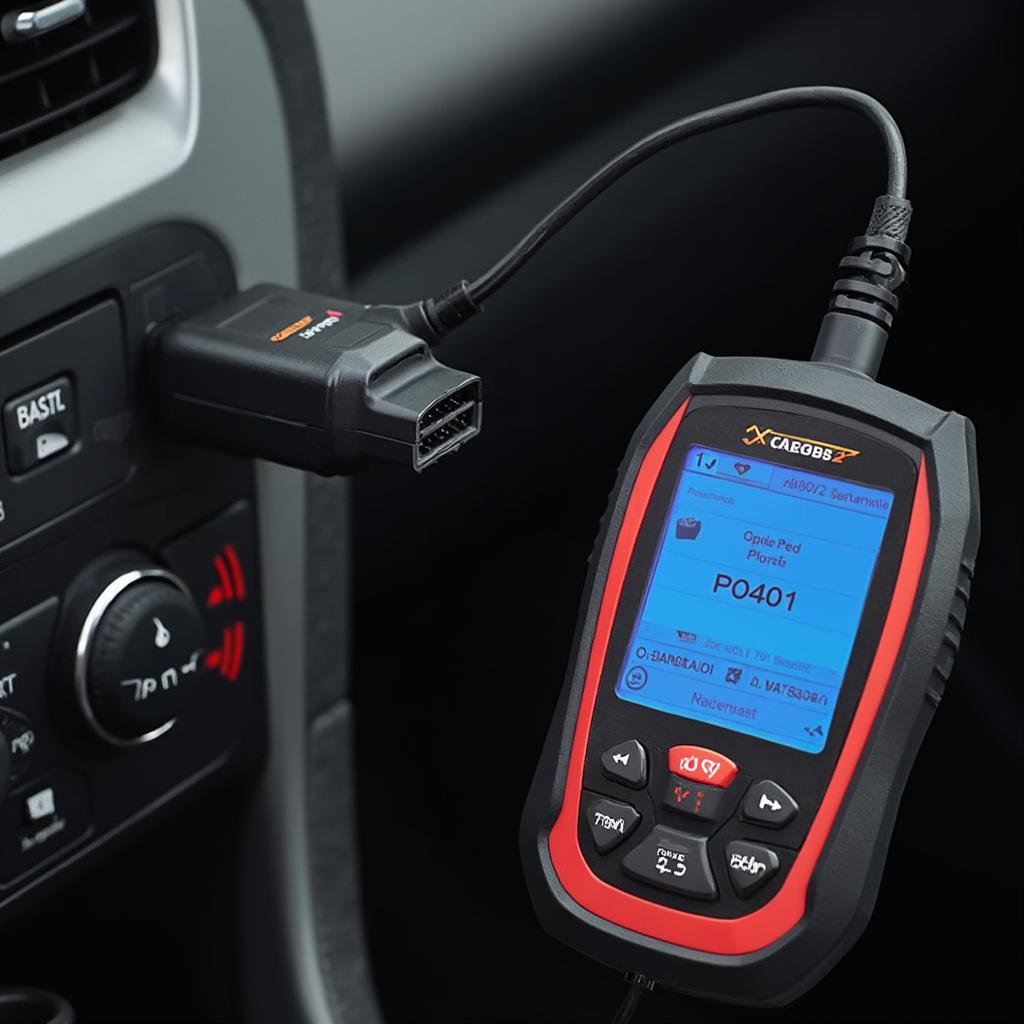The dreaded P0401 OBD2 code, indicating insufficient exhaust gas recirculation (EGR) flow, can be a frustrating issue for car owners. This comprehensive guide will delve into the intricacies of the P0401 code, exploring its causes, symptoms, diagnostic procedures, and potential solutions. We’ll equip you with the knowledge to understand and address this common OBD2 trouble code.
What exactly does the P0401 code mean? The P0401 code signifies that your vehicle’s onboard diagnostic system has detected a problem with the EGR system, specifically insufficient flow. The EGR system plays a vital role in reducing nitrogen oxide (NOx) emissions, a harmful byproduct of combustion. It does this by recirculating a portion of the exhaust gases back into the intake manifold, lowering combustion temperatures and reducing NOx formation.
Decoding the P0401 OBD2 Code
The P0401 code specifically points to a problem with the flow of exhaust gases within the EGR system. This doesn’t necessarily mean the EGR valve itself is faulty. The issue could stem from blocked EGR passages, a malfunctioning EGR valve position sensor, or even a vacuum leak.
Common Causes of P0401
Several factors can contribute to the P0401 code:
- Clogged EGR Valve: Carbon buildup within the EGR valve can restrict or completely block the flow of exhaust gases. This is the most common cause of the P0401 code.
- Faulty EGR Valve Position Sensor: This sensor provides feedback to the engine control module (ECM) regarding the position of the EGR valve. A malfunctioning sensor can lead to inaccurate readings and trigger the P0401 code.
- Blocked EGR Passages: Just like the EGR valve, the passages leading to and from the valve can become clogged with carbon deposits, hindering exhaust gas flow.
- Vacuum Leaks: The EGR system often relies on vacuum pressure to operate. Leaks in the vacuum lines or the EGR valve diaphragm can disrupt the system’s function and cause the P0401 code.
- Wiring Issues: Damaged or corroded wiring connecting the EGR system components can also contribute to the problem.
Recognizing the Symptoms of P0401
While the P0401 code itself is a clear indicator of an issue, other symptoms may accompany it:
- Check Engine Light: The illumination of the check engine light is the most obvious sign.
- Rough Idle: The engine may idle unevenly or stall due to the disrupted airflow.
- Reduced Fuel Economy: The inefficient combustion caused by the EGR problem can lead to decreased fuel mileage.
- Increased NOx Emissions: As the EGR system isn’t functioning correctly, NOx emissions will likely be higher.
- Engine Knocking (Pinging): In some cases, engine knocking or pinging may occur due to increased combustion temperatures.
Diagnosing and Fixing the P0401 OBD2 Code
Diagnosing the P0401 code requires a systematic approach:
- Retrieve the Code: Use an OBD2 scanner to confirm the P0401 code.
- Inspect the EGR Valve: Visually inspect the EGR valve for carbon buildup and clean it if necessary.
- Check the EGR Passages: Inspect and clean the EGR passages for any blockage.
- Test the EGR Valve Position Sensor: Use a multimeter to test the sensor’s resistance and voltage.
- Inspect Vacuum Lines: Check for any leaks or damage in the vacuum lines.
- Test the EGR Solenoid: Verify the proper operation of the EGR solenoid using a multimeter.
“Regular maintenance and timely checks of the EGR system can prevent many P0401 issues,” advises John Smith, Senior Automotive Technician at Auto Experts Inc. “A simple cleaning can often resolve the problem and save you from costly repairs.”
Solutions for P0401
Depending on the diagnosis, the solutions for the P0401 code can range from simple cleaning to component replacement:
- Cleaning the EGR Valve and Passages: Often, a thorough cleaning with a carburetor cleaner can restore proper EGR flow.
- Replacing the EGR Valve: If the valve is damaged or excessively clogged, replacement is necessary.
- Replacing the EGR Valve Position Sensor: A faulty sensor needs to be replaced for accurate EGR system operation.
- Repairing Vacuum Leaks: Any leaks in the vacuum lines should be repaired or the lines replaced.
- Addressing Wiring Issues: Damaged or corroded wiring should be repaired or replaced.
Conclusion: Taking Control of the P0401 OBD2 Code
The P0401 OBD2 code, while potentially troublesome, is often manageable with the right knowledge and tools. Understanding the causes, symptoms, and diagnostic procedures empowers you to address the issue effectively. Regular maintenance and prompt attention to warning signs can prevent the P0401 code and keep your vehicle running smoothly. By taking a proactive approach, you can save yourself from costly repairs and ensure optimal engine performance and emissions control.
FAQ
- Can I drive my car with a P0401 code? While you can technically drive with a P0401 code, it’s not recommended. It can lead to further engine problems and increased emissions.
- How much does it cost to fix a P0401 code? The cost can vary depending on the specific issue and labor rates. It can range from a few dollars for a simple cleaning to a few hundred dollars for component replacement.
- How often should I clean my EGR valve? It’s generally recommended to clean the EGR valve every 30,000 to 50,000 miles.
- Can a bad EGR valve cause other problems? Yes, a malfunctioning EGR valve can contribute to other engine issues such as rough idle, reduced fuel economy, and increased emissions.
- Can I clean the EGR valve myself? Yes, cleaning the EGR valve is a relatively simple procedure that many car owners can perform themselves.
- What tools do I need to clean the EGR valve? You’ll need a carburetor cleaner, a wire brush, and some basic hand tools.
- Is it necessary to replace the entire EGR valve if it’s clogged? Not always. Cleaning the valve can often resolve the issue. However, if the valve is damaged or excessively clogged, replacement might be necessary.
For further assistance, please contact us via WhatsApp: +1(641)206-8880, Email: [email protected] or visit us at 789 Elm Street, San Francisco, CA 94102, USA. Our 24/7 customer service team is ready to help.

